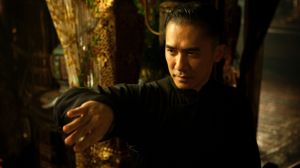"(Sammo Hung) is the best action director ever in Hong Kong cinema." - Wong Kar Wai
A quote like that makes me wonder what must have happened. I mean, if director Wong Kar Wai felt that way when he made Ashes of Time, it stands to reason that he and Hung would reunite for The Grandmaster - his first martial arts epic since that film.
But a lot has happened since 1994. Namely, The Matrix, Crouching Tiger Hidden Dragon, and Kill Bill Vols. 1 and 2. The past 15 or so years have seen you become the go-to guy for Hollywood martial arts choreography. So when Wong started on this biography of the legendary Ip Man, you must have been an obvious choice. The fact that Hung had himself choreographed the action for a previous Ip Man biopic (called, appropriately enough, Ip Man) may have also been an influence, as Wong likes to give his films unique looks and moods.
Of course you must have known that while The Grandmaster would show how Ip Man helped popularize and democratize Chinese martial arts, it would certainly not be your standard martial arts film. Wong is too interested in people--faces, to be specific--to focus too long on the action. Don't get me wrong, your work is on fine display here. When the action comes, it's at once furious and poetic. But Wong adds a layer of abstraction to the fights with his signature stylistic flourishes that break the action into smears of colour and light.
And those faces. As much as anyone working today, Wong certainly understands the power of a close-up. Anchoring the narrative with stars as beautiful as Tony Leung and Ziyi Zhang doesn't hurt, either. Leung, as Ip Man, and Zhang, as Gong Err, give the film its shape as romantic might-have-beens, their relationship illustrated over a series of encounters that mostly span the Second Japanese Sino War. Both martial arts masters, Ip and Gong initially meet as rivals, engaging in a playful fight that combines your graceful choreography and Wong's emotional intensity in an erotically charged dance. As he showed in 2000's In the Mood for Love, Wong knows that it's often what's not said--or acted upon--that packs the biggest punch.
Surrounding this central relationship, there are other more traditional showcases for your work. Ip, for example, engages masters of different marital arts disciplines in his quest to create greater respect for Wing Chun, the (at the time) little-known style he teaches. All of these encounters, romantic or combative, are structured as narrative way points with very direct onscreen titles that fill in the gaps between scenes. Because this version of The Grandmaster has been recut (by Wong himself) specifically to help Western audiences through some of the less familiar elements of Chinese history, these titles (which cover some major events in Ip's life) have a matter-of-factness that contrasts with the deep emotions of what does play out onscreen. Or maybe the emotional intensity is raised because of this contrast. Whatever the reason, as ungainly as it sounds, it works. Like the ways Ip is constantly called on to prove his backwoods style is the equal of more the established fighting forms, The Grandmaster's form shows that art comes from the unlikeliest of combinations.
Bowing in respect,
Casey







